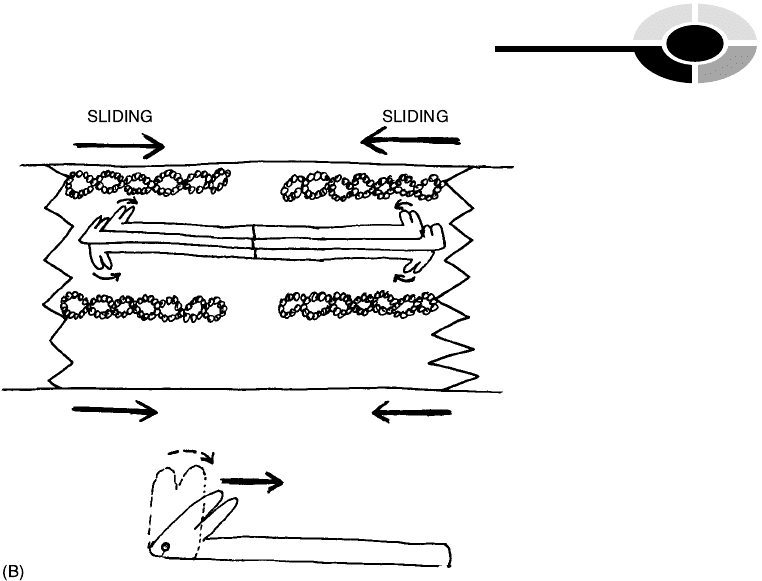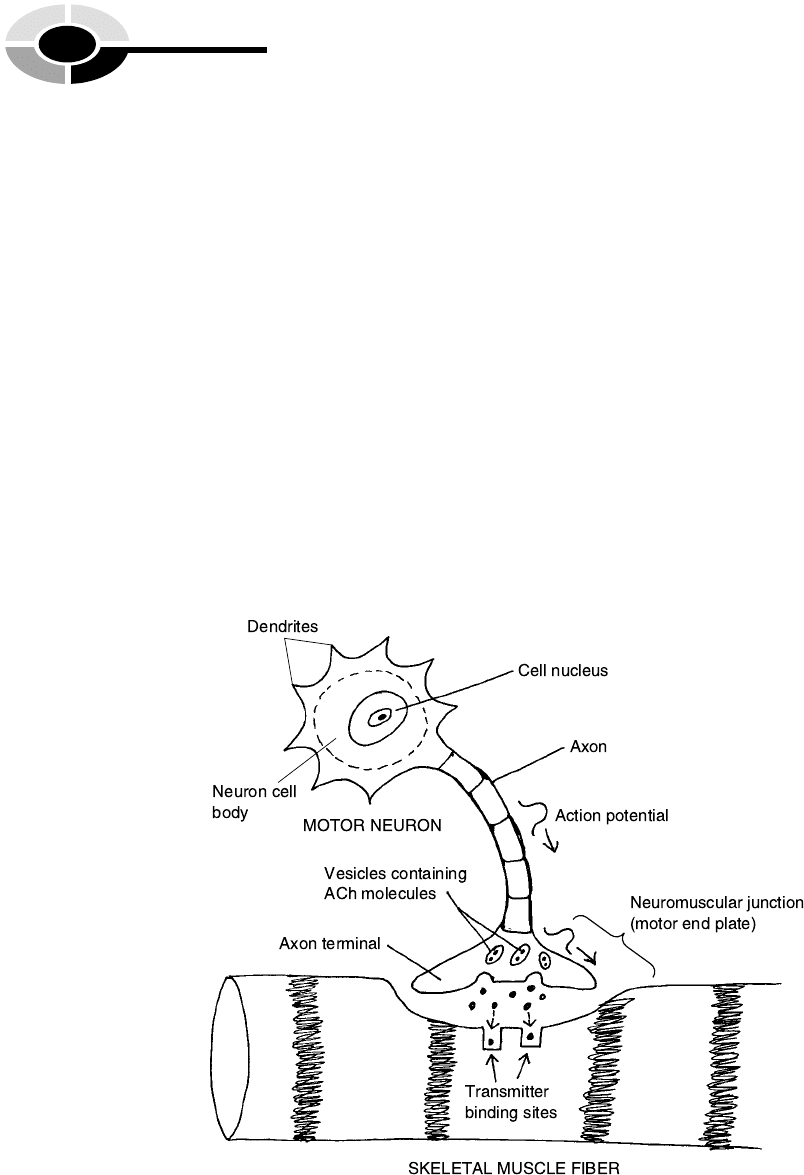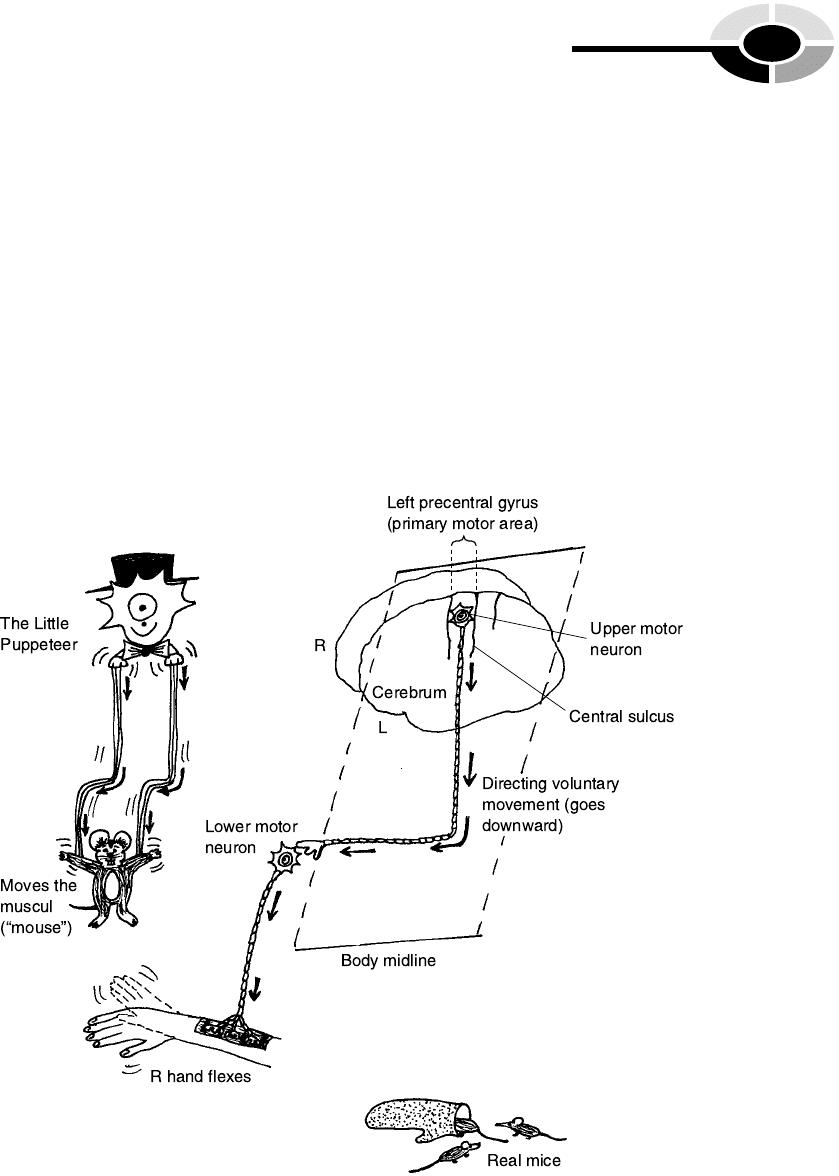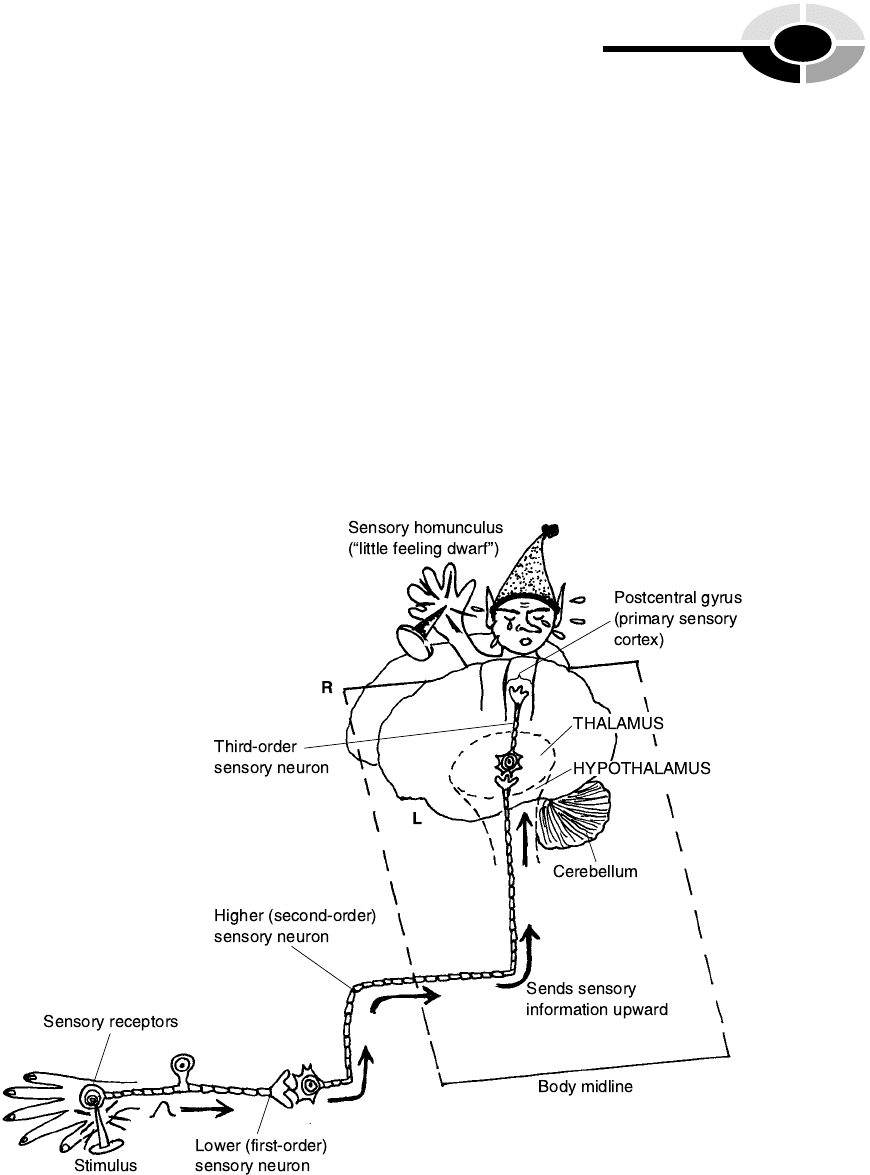Layman D. Biology Demystified: A Self-Teaching Guide
Подождите немного. Документ загружается.


general mechanism of shortening is much the same. To understand its basic
features, we must examine the interior of a sarcomere (Figure 14.7). Within
the sarcomere are a number of myofilaments (my-oh-FIL-ah-ments) or ‘‘mus-
cle threads.’’ In reality, these myofilaments are thread-like collections of
protein molecules. Attached to the Z-line at either end of the sarcomere
are a series of thin actin (AK-tin) myofilaments. Each of these thin actin
myofilaments consists of two twisted strands of globe-shaped actin proteins.
[Study suggestion: Find a beaded pearl necklace and lay it upon a surface.
Place both strands of the necklace side-by-side, then twist them around each
other. The resulting double helix (two twisted strands) provides a rough
model for a thin actin myofilament.]
In the middle of each sarcomere is a series of thick myosin (MY-oh-sin)
myofilaments. These are stacked vertically above-and-below one another,
with narrow gaps between them. Each myosin myofilament consists of doz-
ens of individual myosin protein molecules. Each myosin protein somewhat
resembles a golf club with two heads. The double-heads are tiltable, as if they
were poised upon a chemical hinge. The tiltable double-head of each myosin
molecule is technically called a myosin cross-bridge.[Study suggestion:
Visualize two golfers, each carrying their own bag of golf clubs. Each club
has a double-head at one end, which is attached by a tiltable hinge. The two
golfers stand back-to-back, in the center of a sarcomere, and then each gives
his golf bag a heave. If the golfers keep hold of their bags, their clubs will
come flying out in both directions, some with their double-heads pointing
upward, and some with their double-heads pointing down. The resulting
highly orderly arrangement provides a rough model for the thick myosin
myofilament.]
The myosin cross-bridge is the chief contact point between the thin actin
and thick myosin myofilaments. It is also vitally important because of its
close functional relationship with the high-energy ATP molecule. You may
remember (Chapter 4) that the ATP molecule is split by a special kind of
enzyme, called ATPase. In the case of muscle, the enzyme is myosin
ATPase.
THE SLIDING FILAMENT THEORY
According to the sliding filament theory of muscle contraction, muscles
shorten due to the inward sliding of the thin actin myofilaments over the
tilted cross-bridges of the thick myosin myofilaments. ‘‘How is this accom-
plished?’’ you might reasonably question. The answer involves the action of
myosin ATPase.
CHAPTER 14 Neuromuscular Connection 247
[13:26 13/6/03 N:/4058 LAYMAN.751/4058-Alltext.3d] Ref: 4058 Layman: Biology Demystified All-text Page: 247 1-388
4, Order

When the skeletal muscle fiber is excited by a nerve ending, myosin
ATPase enzyme splits ATP molecules in the region of the myosin cross-
bridges. The resulting free energy tilts the myosin cross-bridges inward. As
the cross-bridges tilt, the overhanging thin actin myofilaments slide over their
tips. The sliding occurs at both ends of the sarcomere. Hence, each sarcomere
shortens. Since each myofibril organelle consists of a series of sarcomeres
hooked end-to-end, the whole myofibril shortens. And as all of their myofi-
bril organelles shorten, the entire skeletal muscle fiber (cell) also shortens.
It is this shortening of many muscle fibers that yanks upon a tendon,
creating a pulling force upon a bone that results in body movement.
[13:26 13/6/03 N:/4058 LAYMAN.751/4058-Alltext.3d] Ref: 4058 Layman: Biology Demystified All-text Page: 248 1-388
PART 4 Anatomy and Physiology of Animals
248
Fig. 14.7 Myofilaments and the sliding filament theory of muscle contraction. (A) Resting
(non-contracting position). (B) Contracting process: thin myofilaments slide
inward; sarcomere shortens.

[13:26 13/6/03 N:/4058 LAYMAN.751/4058-Alltext.3d] Ref: 4058 Layman: Biology Demystified All-text Page: 249 1-388
After the muscle contracts, the cross-bridges tilt back into their vertical
positions, causing the thin actin myofilaments to slide outward, again. The
sarcomere re-lengthens, and the muscle fiber relaxes. This same highly
orderly sequence of muscle contraction (shortening) followed by relaxation
(lengthening) repeats itself over and over again. And each time, the trigger
for the contraction–relaxation sequence to begin is a sufficiently strong level
of muscle fiber excitation by nearby nerve endings.
The Neuromuscular Junction and Muscle
Excitation
Remember that this chapter is entitled ‘‘The Neuromuscular (Nerve–Muscle)
Connection.’’ A critical element in this connection is the motor neuron. As its
name suggests, a motor neuron is a nerve cell that excites a muscle to contract
(or a gland to secrete), thereby causing movement. Thus, this type of neuron
results in the moving of a vertebrate body, in somewhat the same sense that a
motor ultimately causes the body of a car to move.
CHAPTER 14 Neuromuscular Connection 249
Fig. 14.7 (continued)

Figure 14.8 illustrates the main parts of a typical motor neuron. There are
a number of dendrites (DEN-dryts) at one end of the nerve cell. These den-
drites are actually slender branches of cytoplasm that carry excitation toward
the cell body (major central portion) of the neuron. [Study suggestion: Why
do you think this word derives from the Greek for ‘‘of a tree’’?]
When the cell body is sufficiently excited, it fires off an action potential or
nerve impulse. The action potential (nerve impulse) can most simply be con-
sidered a wave. It is a traveling wave of chemical excitation that passes from
the neuron cell body, and then onto the neuron axon (AX-ahn).
The axon is like a long slender ‘‘axle’’ holding two car wheels. Although
the axon doesn’t move, it is a long, slender branch of cytoplasm that carries
excitation (an action potential) away from the cell body of a neuron. The
action potential or nerve impulse travels down the axon to its branching tips,
called the axon terminals.
Within the axon terminals are tiny vesicles (VES-ih-kls). Each vesicle is
literally a ‘‘tiny bladder’’ that consists of a membrane surrounding thousands
of neurotransmitter (NUR-oh-trans-mit-er) molecules. Each time an action
[13:26 13/6/03 N:/4058 LAYMAN.751/4058-Alltext.3d] Ref: 4058 Layman: Biology Demystified All-text Page: 250 1-388
PART 4 Anatomy and Physiology of Animals
250
Fig. 14.8 The neuromuscular junction and muscle excitation.

[13:26 13/6/03 N:/4058 LAYMAN.751/4058-Alltext.3d] Ref: 4058 Layman: Biology Demystified All-text Page: 251 1-388
potential travels down into the axon terminals, the membranes surrounding
some of the vesicles rupture.
Hundreds of neurotransmitter molecules are then released into the neuro-
muscular junction, which is also called the motor end plate. The neuromus-
cular junction (motor end plate) is the flat, plate-like area where the axon
terminals of a motor neuron almost (but not quite) touch the cell membrane
of a muscle fiber.
THE PROCESS OF MUSCLE FIBER EXCITATION
The released neurotransmitter molecules diffuse across the narrow, saltwater-
filled gap of the neuromuscular junction, then attach to transmitter binding
sites on the muscle fiber. What happens to the muscle fiber, then, is largely
determined by the nature of the neurotransmitter molecules that are released
and attached to the binding sites.
Excitatory neurotransmitter molecules stimulate or excite the skeletal mus-
cle fiber to contract. The main excitatory neurotransmitter in the human
neuromuscular junction is called acetylcholine (uh-see-tul-KOH-leen), abbre-
viated as ACh.
Motor Pathways
The neuromuscular junction (motor end plate) can be considered the func-
tional end of a particular motor pathway. A motor pathway is a sequence of
one or more motor neurons that carries an action potential to a neuromus-
cular junction, thereby resulting in muscle contraction.
From this definition, you can see that a lower motor neuron is the one
whose axon and axon terminals actually makes a neuromuscular junction
with one or more skeletal muscle fibers. ‘‘Where is the cell body of this lower
motor neuron located?’’ the inquiring mind needs to know. Quite often, the
cell body of the lower motor neuron is located in the gray matter of the spinal
cord (Figure 14.9). The axon then extends outward into the white matter,
entering a spinal nerve.
The spinal nerve travels some distance away from the spinal cord. The
motor neuron axons within the spinal nerve carry the action potential away
from the central region of the whole body, and hence to the ‘‘outer portion’’
or periphery (per-IF-eh-ree). As it reaches the body periphery, the spinal
nerve branches into one or more peripheral (per-IF-er-al) nerves. It is the
CHAPTER 14 Neuromuscular Connection 251

peripheral nerve, then, that forms the last major linkage in the motor path-
way. From here, the axon terminals of the lower motor neuron branch out
and make a neuromuscular junction with one or more skeletal muscle fibers.
Excitatory neurotransmitter (such as acetylcholine, ACh) is released, the
skeletal muscle fibers are stimulated, and the fibers contract.
The spinal nerves and individual peripheral nerves leading to various ske-
letal muscles are considered parts of the Peripheral Nervous System or PNS.
This name is due to the fact that they supply the body periphery (outer
portion).
HIGHER MOTOR NEURONS WITHIN THE CNS
We have explained how a lower motor neuron in the gray matter of the spinal
cord can excite skeletal muscle fibers to contract. The next question to con-
sider is, ‘‘What is it that excites a lower motor neuron, so that it can then
excite skeletal muscle?’’
The answer is that a series of one or more higher motor neurons within a
particular motor pathway eventually stimulates a lower motor neuron. The
cell bodies of such higher motor neurons generally lie within the Central
Nervous System, which is abbreviated as CNS. The Central Nervous
System (CNS) is the portion of the nervous system that is centrally located
within the skull and the vertebral column. Specifically,
Central Nervous System ¼ Brain þ Spinal cord
ðCNSÞ
[13:26 13/6/03 N:/4058 LAYMAN.751/4058-Alltext.3d] Ref: 4058 Layman: Biology Demystified All-text Page: 252 1-388
PART 4 Anatomy and Physiology of Animals
252
Fig. 14.9 A lower motor neuron and its pathway.

The brain is technically the upper portion of the CNS that lies within the
skull. The spinal cord, in contrast, is the narrow, ‘‘cord’’-like lower portion of
the CNS that is housed within the vertebral column.
Figure 14.10 provides an overview of the CNS, along with the relative
positions of the brain and spinal cord. One especially important location
for higher motor neurons in the brain is an area called the precentral gyrus
(JEYE-rus). The name gyrus means ‘‘ring’’ or ‘‘fold.’’ The precentral gyrus,
therefore, is a raised ring or fold of brain tissue located just ‘‘before’’ or ‘‘in
front of ’’ (pre-) a groove called the central sulcus (SUL-kus).
The precentral gyrus lies at the superior end of the cerebrum (seh-REE-
brum) or ‘‘main brain mass.’’ Since this gyrus is at the surface, it is part of the
cerebral cortex (KOR-tex) or gray matter ‘‘bark’’ covering the ‘‘main brain
CHAPTER 14 Neuromuscular Connection 253
[13:26 13/6/03 N:/4058 LAYMAN.751/4058-Alltext.3d] Ref: 4058 Layman: Biology Demystified All-text Page: 253 1-388
Fig. 14.10 Higher motor neurons and the hidden puppeteer.

mass.’’ The upper motor neurons situated within the cerebral cortex of the
precentral gyrus often direct voluntary movements of the body to occur.
The precentral gyrus is sometimes called the primary motor area. It is here
that upper motor neurons ‘‘decide’’ to initiate the movements of various
skeletal muscles (usually on the opposite side of the body). From the primary
motor area (precentral gyrus), motor nerve fibers descend, cross over the
body midline, and then stimulate skeletal muscles on the opposite side of
the body to contract. To move your right hand, for instance, upper motor
neurons within the left precentral gyrus would send down a message, which
would eventually cross to the right side of the spinal cord, then out to the
muscles in the right hand.
[Study suggestion: Imagine a mischievous little puppeteer hiding within
your left precentral gyrus. The strings manipulating his puppet hang down
(descend) for some distance. These ‘‘strings’’ are actually nerve fibers in a
motor pathway. After the strings are pulled (excited by a muscle action
potential), they activate the puppet (skeletal muscle) to contract.]
Sensory Pathways
Just as motor pathways descend or come down from both higher and lower
motor neurons, sensory pathways ascend or rise up from sensory neurons.A
lower or first-order sensory neuron is a nerve cell that has part of its dendrites
modified to form sensory receptors. Sensory receptors are specialized nerve
endings that are sensitive to a particular kind of ‘‘goad’’ (poking prod) called
a stimulus (STIM-yuh-les).
Consider, for example, certain onion-shaped sensory receptors in the skin
of the right hand (Figure 14.11). They are sensitive to touch or pressure
sensations. A nerve impulse is created, and then it travels over a peripheral
nerve, then a spinal nerve, and into the spinal cord. A higher or second-order
sensory neuron is then excited. Its axon crosses the body midline to the left
side of the spinal cord, and then ascends towards the thalamus (THAL-uh-
mus).
The thalamus is an egg-shaped ‘‘bedroom’’ (thalam) – an oval region
nestled deep within the cerebrum. The thalamus is often described as a sen-
sory relay center. This is because sensory nerve impulses (action potentials)
are often switched over (or relayed) up onto third-order sensory neurons,
whose cell bodies lie within the thalamus. And from the thalamus, the
axons of the third-order sensory neurons finally carry the information
about the stimulus all the way up to the postcentral gyrus.
[13:26 13/6/03 N:/4058 LAYMAN.751/4058-Alltext.3d] Ref: 4058 Layman: Biology Demystified All-text Page: 254 1-388
PART 4 Anatomy and Physiology of Animals
254

As its name clearly indicates, the postcentral gyrus is a raised ring or fold
of cerebral cortex that runs up and down just behind or ‘‘after’’ (post-) the
central sulcus. The postcentral gyrus is alternately called the primary or gen-
eral sensory cortex. This name reflects the fact that the postcentral gyrus area
is the final destination for most of our general or primary body senses, such
as touch, pressure, temperature, vibration, and pain.
Remember that we imagined there was a hidden puppeteer within the left
precentral gyrus, directing much of the motor pathway descending on the
right side of the body. Likewise, we can draw a sensory homunculus (hoh-
MUNG-kyuh-lus) – a ‘‘little feeling man or dwarf ’’ (homuncul ) – just above
the left postcentral gyrus. This little feeling dwarf is a rather bizarre visual
method by which anatomists have commonly mapped the final destinations
of sensory nerve fibers ascending from various parts on the right side of the
body.
CHAPTER 14 Neuromuscular Connection 255
[13:26 13/6/03 N:/4058 LAYMAN.751/4058-Alltext.3d] Ref: 4058 Layman: Biology Demystified All-text Page: 255 1-388
Fig. 14.11 The primary sensory pathway and its ‘‘little man’’ or ‘‘dwarf ’’.

[13:26 13/6/03 N:/4058 LAYMAN.751/4058-Alltext.3d] Ref: 4058 Layman: Biology Demystified All-text Page: 256 1-388
PART 4 Anatomy and Physiology of Animals
256
The Cerebellum and Hypothalamus
The thalamus and postcentral gyrus (primary or general sensory cortex) are
not the only places in the human brain that receive sensory information. Two
other very important sensory areas are the cerebellum (sair-uh-BELL-um) or
‘‘little cerebrum’’ (cerebell) and the hypothalamus (high-poh-THAL-uh-mus)
or region ‘‘below’’ (hypo-) the ‘‘thalamus.’’ (Review Figure 14.11.)
The cerebellum is involved in proprioception (proh-pree-oh-SEP-shun).
This long term literally means ‘‘the process of receiving’’ (-ception) sensations
from ‘‘one’s own’’ (propri) self. In more direct language, proprioception
involves the receiving of sensory stimuli that indicate the relative position
of the entire body and its parts within space. The sensory receptors for
proprioception are often found within the skeletal muscles and joints.
Thus, you can sense or feel that you are standing upright, or that you have
raised your arm up off a table, without even having to look! By providing
proprioception, the cerebellum helps the body maintain its vertical balance
and reduces the amount of shaking during automatic reflex movements.
THE HYPOTHALAMUS AND NEGATIVE FEEDBACK
The hypothalamus, like the thalamus, lies buried deep within the cerebrum. It
contains a number of control centers for homeostasis. It includes, for
instance, the temperature control center. Recall (Chapter 1) that oral body
temperature usually varies up-and-down in a roughly S-shaped pattern,
within its normal range. And remember (Chapter 13) how thermoregulation
(homeostasis of body temperature) is maintained by processes occurring
within the skin, such as sweating and vasodilation. The logical question we
can ask is, ‘‘Okay, just what part of the body is it, that controls the mechan-
isms responsible for carrying out thermoregulation?’’ The answer is this:
Certain neurons within the temperature control center of the hypothalamus
establish and maintain the set-point for oral body temperature. A set-point is
defined as the long-term average value of a body variable: that is, it is the
point at which the variable seems to be set. Oral body temperature, for
example, seems to be set at an average value of about 98.6 degrees F.
[Study suggestion: Visualize the thermostat in your own house or apartment.
What is the usual ‘‘set-point’’ temperature where you keep the thermostat?]
Obviously, when certain factors raise the body temperature too far above
this set-point (or too far below it), then some type of control system has to be
engaged. Usually, the human body uses a negative feedback control system to
correct or minimize the amount of change.
5, Order
